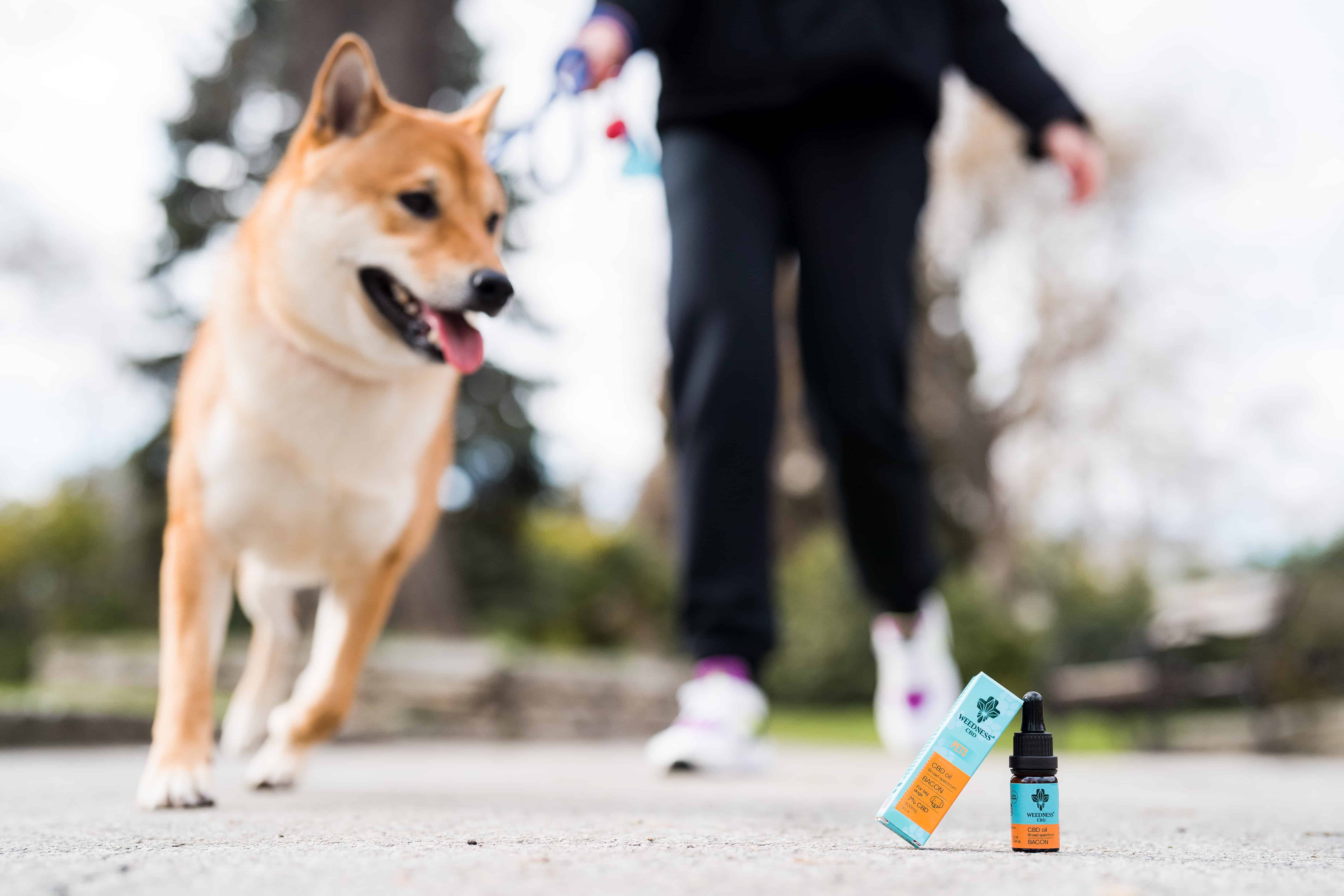Weedness CBD for Pets: Exploring the Canine ECS

The endocannabinoid system (ECS) is one system in the complex realm of canine physiology that stands out because of its significant effects on our pet's general well-being. Dogs of all ages and breeds benefit from the ECS in maintaining their overall health, just like humans do. Understanding how the active ingredients in hemp or marijuana improve mental and physical health can help explain how CBD for dogs functions in the body.
The Endocannabinoid System and The Cannabis Plant
All mammals possess the endocannabinoid system, even if they have never come into contact with cannabis plants. The endogenous chemicals produced by this system complement those present in Earth Buddy's organic hemp extract. Among other biological processes, it supports the immune and central nervous systems, mood, appetite, sleep, and discomfort.
Natural-occurring cannabinoids have been repeatedly found in many different chemical pathways in human bodies. Although receptors for the endocannabinoid system are found all over the body, the brain and digestive tract have the greatest concentrations of these receptors (central nervous system).
Activation of the endocannabinoid system, whether through natural processes or from plant-derived cannabinoids, prompts pathways to restore balance and address dysfunction. However, as the CBD for pets ages, the endocannabinoid system can become deficient, so many pet parents notice a difference in their pets when they start a Weedness CBD regimen.
You should first gain a fundamental understanding of the functions of the endocannabinoid system before we delve more into how CBD promotes and supports long-term health.
The Endocannabinoid System of Dogs: Endocannabinoids
The body's endogenous cannabinoids, or endocannabinoids, are essential elements of the canine ECS. Endocannabinoids play a variety of biological functions in dogs, much like they do in human physiology. All mammals, including dogs and humans, have been found to have the following main endocannabinoids:
2-Arachidonoylglycerol (2-AG): Mainly located in the central nervous system, 2-AG helps control hunger, mood, and some immunological responses in dogs.
Anandamide: Also referred to as the "bliss molecule," anandamide controls several functions in dogs, such as hunger stimulation and mood enhancement.
These lipid-based neurotransmitters mediate different physiological responses in dogs by interacting smoothly with particular receptors dispersed throughout their body. Either receptor will allow them to bind. The location of the receptor and the endocannabinoid it binds determine the outcome of the interaction.
Enzymes in the ECS
To avoid chronic activity, these molecules must be quickly broken down when they've fulfilled their function. Enzymes such as FAAH and MAGL are responsible for the breakdown of these endocannabinoids. Each one of these enzymes needs to carry out a particular function.
Fatty Acid Amide Hydrolase (FAAH) and Anandamide
The main enzyme that breaks down anandamide is FAAH. FAAH aids in controlling the body's anandamide concentration by hydrolyzing it, preventing overstimulation of the ECS receptors and upsetting the system's equilibrium. Considering the role anandamide plays in mood control and other physiological processes, inhibiting FAAH and raising anandamide levels have been proposed as a possible therapeutic approach.
Monoacylglycerol Acid Lipase (MAGL) and 2-AG
The primary enzyme that breaks down 2-AG into glycerol and arachidonic acid is called MAGL. This degradation is essential for 2-AG's biological effects to end. Because of 2-AG's involvement in neuroinflammation, neurodegeneration, and other central nervous system processes, inhibitors of MAGL, like FAAH, have been researched for possible uses.
The Role of the Canine Endocannabinoid System
The ability of the ECS to maintain homeostasis is what gives dogs their primary benefit. The ECS is always involved, whether controlling appetite following an accident or affecting mood and sleep habits.
Endocannabinoid Deficiency Found in Clinical Trials
The term "endocannabinoid deficiency" describes the possibility that dogs occasionally do not have adequate levels of specific natural substances in their bodies. These substances help maintain equilibrium, much like a thermostat controls the temperature of a space. Dogs may face health issues if their bodies do not produce enough of these endogenous cannabinoids.
There is a belief that dogs may have this impairment, just as some think it only affects humans. According to observations, some dogs with particular health issues may have lower levels of these important cannabinoid signaling pathways.
How CBD Oil Works on the Brain?
The brain is slightly impacted by cannabidiol, or CBD oil for dogs and cats, on various receptors and neurotransmitter systems. The most obvious effect is CBD's affinity for serotonin receptors, specifically 5-HT1A receptors, which contributes to improved pet brain function. CBD may contribute to the preservation of regular nervous system function by affecting this receptor. Furthermore:
Through its interaction with the brain's neurotransmitters, full-spectrum hemp extract:
-
Improves mental performance
-
Encourages typical, healthy brain function
-
Helps the brain regularly use oxygen and balance serotonin levels.
Full-spectrum hemp extract improves GABA signaling:
-
Helps dogs keep their typical, calm demeanor
-
Aids in preserving your pet's happiness amid separation, travel, motion sickness, and stress brought on by adjustments to their regular schedule.
-
It could ease hyperactivity and encourage calm
How Long Does CBD Take to Work on Dogs?
Dogs may respond differently and uniquely to CBD. The time required to ascertain the ideal dosage for each unique pet cannot be answered in a generalized way. Its effectiveness depends on the particular issue being addressed as well as the distinct physiology of each pet. It is important to use a thorough and patient approach, starting with a modest dose and increasing or decreasing the amount as necessary.
Start with the suggested dosage listed on the product's label and continue for a week or a little longer to see if the present amount is working. If you see improvements, keep taking that dose. If no noticeable changes occur, consider a moderate increase, and then give your pet another week or so to watch them. This technique should be repeated until the lowest effective dosage is determined.
Investigating CBD Products Derived from Hemp
Full-spectrum CBD oil for dogs and cats is essential to guarantee that CBD derived from hemp will function as well as possible. To get the best effects when combined, full-spectrum hemp products keep as many of the original ingredients as possible, such as THC and CBD. This leads to the phenomenon known as the entourage effect.
The entourage effect's all-encompassing effects could be jeopardized without a full-spectrum composition. The product's effectiveness results from the harmonious combination of several substances found in the hemp plant, such as THC, CBD, CBG, CBDa, terpenes, and other natural elements. Simply put, the extract from the entire plant has a greater synergy than the sum of its individual parts.
Conversely, more thorough processing has been applied to pure CBD isolates and broad-spectrum CBD products, eliminating many complex molecules that improve the functioning of the endocannabinoid system. The depletion of these components may reduce the product's overall potency. Because of this, the main question regarding broad-spectrum versions becomes whether they will function at all rather than how long and at what dosage it will take to feel the benefits.
Treatments Using CBD Oils Might Take More Time
If you give your dog treats containing full-spectrum hemp plant extract instead of a tincture, you may observe a longer period of time before your dog shows any symptoms. The chemicals can quickly interact with the endocannabinoid system through the bloodstream when using the direct tincture approach. On the other hand, it must first go through the digestive process when offered as a treat.
CBD treats are an effective substitute if your pet won't tolerate the tincture on their gums or mouth. Just keep in mind that eating it could take longer. This delay is because your dog's digestive system must absorb the CBD in the treats before it can enter the bloodstream.




